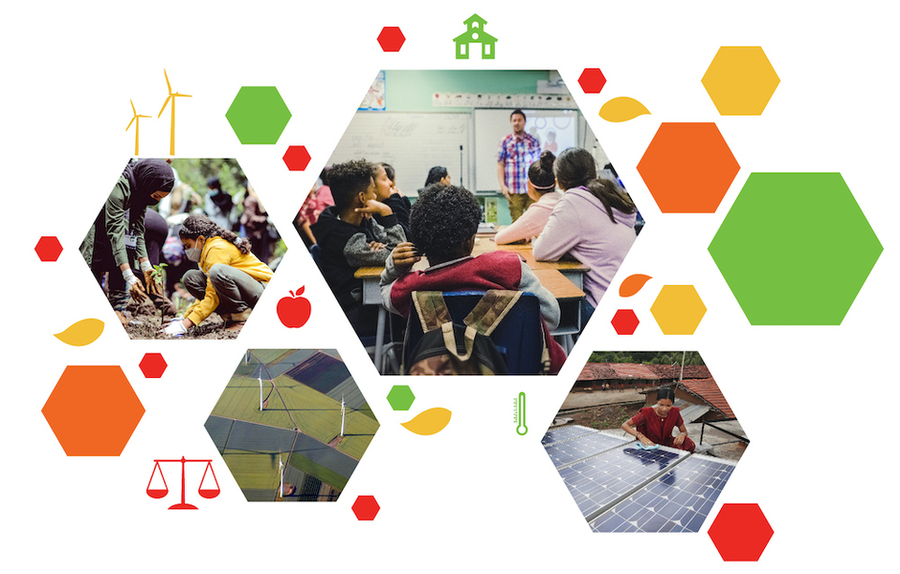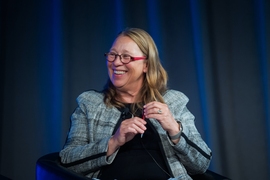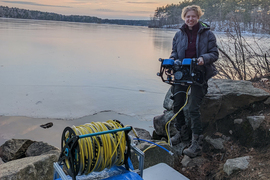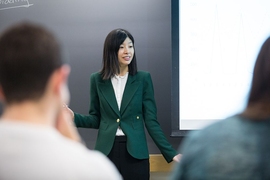Several years ago, Christopher Knittel’s father, then a math teacher, shared a mailing he had received at his high school. When he opened the packet, alarm bells went off for Knittel, who is the George P. Shultz Professor of Energy Economics at the MIT Sloan School of Management and the deputy director for policy at the MIT Energy Initiative (MITEI). “It was a slickly produced package of materials purporting to show how to teach climate change,” he says. “In reality, it was a thinly veiled attempt to kindle climate change denial.”
Knittel was especially concerned to learn that this package had been distributed to schools nationwide. “Many teachers in search of information on climate change might use this material because they are not in a position to judge its scientific validity,” says Knittel, who is also the faculty director of the MIT Center for Energy and Environmental Policy Research (CEEPR). “I decided that MIT, which is committed to true science, was in the perfect position to develop its own climate change curriculum.”
Today, Knittel is spearheading the Climate Action Through Education (CATE) program, a curriculum rolling out in pilot form this year in more than a dozen Massachusetts high schools, and eventually in high schools across the United States. To spur its broad adoption, says Knittel, the CATE curriculum features a unique suite of attributes: the creation of climate-based lessons for a range of disciplines beyond science, adherence to state-based education standards to facilitate integration into established curricula, material connecting climate change impacts to specific regions, and opportunities for students to explore climate solutions.
CATE aims to engage both students and teachers in a subject that can be overwhelming. “We will be honest about the threats posed by climate change but also give students a sense of agency that they can do something about this,” says Knittel. “And for the many teachers — especially non-science teachers — starved for knowledge and background material, CATE offers resources to give them confidence to implement our curriculum.”
Partnering with teachers
From the outset, CATE sought guidance and hands-on development help from educators. Project manager Aisling O’Grady surveyed teachers to learn about their experiences teaching about climate and to identify the kinds of resources they lacked. She networked with MIT’s K-12 education experts and with Antje Danielson, MITEI director of education, “bouncing ideas off of them to shape the direction of our effort,” she says.
O’Grady gained two critical insights from this process: “I realized that we needed practicing high school teachers as curriculum developers and that they had to represent different subject areas, because climate change is inherently interdisciplinary,” she says. This echoes the philosophy behind MITEI’s energy studies minor, she remarks, which includes classes from MIT’s different schools. “While science helps us understand and find solutions for climate change, it touches so many other areas, from economics, policy, environmental justice and politics, to history and literature.”
In line with this thinking, CATE recruited Massachusetts teachers representing key subject areas in the high school curriculum: Amy Block, a full-time math teacher, and Lisa Borgatti, a full-time science teacher, both at the Governor’s Academy in Byfield; and Kathryn Teissier du Cros, a full-time language arts teacher at Newton North High School.
The fourth member of this cohort, Michael Kozuch, is a full-time history teacher at Newton South High School, where he has worked for 24 years. Kozuch became engaged with environmental issues 15 years ago, introducing an elective in sustainability at Newton South. He serves on the coordinating committee for the Climate Action Network at the Massachusetts Teachers Association. He also is president of Earth Day Boston and organized Boston’s 50th anniversary celebration of Earth Day. When he learned that MIT was seeking teachers to help develop a climate education curriculum, he immediately applied.
“I’ve heard time and again from teachers across the state that they want to incorporate climate change into the curriculum but don’t know how to make it work, given lesson plans and schedules geared toward preparing students for specific tests,” says Kozuch. “I knew that for a climate curriculum to succeed, it had to be part of an integrated approach.”
Using climate as a lens
Over the course of a year, Kozuch and fellow educators created units that fit into their pre-existing syllabi but were woven through with relevant climate change themes. Kozuch already had some experience in this vein, describing the role of the Industrial Revolution in triggering the use of fossil fuels and the greenhouse gas emissions that resulted. For CATE, Kozuch explored additional ways of shifting focus in covering U.S. history. There are, for instance, lessons looking at westward expansion in terms of land use, expulsion of Indigenous people, and environmental justice, and at the Baby Boom period and the emergence of the environmental movement.
In English/language arts, there are units dedicated to explaining terms used by scientists and policymakers, such as “anthropogenic,” as well as lessons devoted to climate change fiction and to student-originated sustainability projects.
The science and math classes work independently but also dovetail. For instance, there are science lessons that demystify the greenhouse effect, utilizing experiments to track fossil fuel emissions, which link to math lessons that calculate and graph the average rate of change of global carbon emissions. To make these classes even more relevant, there are labs where students compare carbon emissions in Massachusetts to those of a neighboring state, and where they determine the environmental and economic costs of plugging in electric devices in their own homes.
Throughout this curriculum-shaping process, O’Grady and the teachers sought feedback from MIT faculty from a range of disciplines, including David McGee, associate professor in the Department of Earth, Atmospheric and Planetary Sciences. With the help of CATE undergraduate researcher Heidi Li ’22, the team held a focus group with the Sustainable Energy Alliance, an undergraduate student club. In spring 2022, CATE convened a professional development workshop in collaboration with the Massachusetts Teachers Association Climate Action Network, Earth Day Boston, and MIT’s Office of Government and Community Relations, sponsored by the Beker Foundation, to evaluate 15 discrete CATE lessons. One of the workshop participants, Gary Smith, a teacher from St. John’s Preparatory School in Danvers, Massachusetts, signed on as a volunteer science curriculum developer.
“We had a diverse pool of teachers who thought the lessons were fantastic, but among their suggestions noted that their student cohorts included new English speakers, who needed simpler language and more pictures,” says O’Grady. “This was extremely useful to us, and we revised the curriculum because we want to reach students at every level of learning.”
Reaching all the schools
Now, the CATE curriculum is in the hands of a cohort of Massachusetts teachers. Each of these educators will test one or more of the lessons and lab activities over the next year, checking in regularly with MIT partners to report on their classroom experiences. The CATE team is building a Climate Education Resource Network of MIT graduate students, postdocs, and research staff who can answer teachers’ specific climate questions and help them find additional resources or datasets. Additionally, teachers will have the opportunity to attend two in-person cohort meetings and be paired with graduate student “climate advisors.”
In spring 2023, in honor of Earth Day, O’Grady and Knittel want to bring CATE first adopters — high school teachers, students, and their families — to campus. “We envision professors giving mini lectures, youth climate groups discussing how to get involved in local actions, and our team members handing out climate change packets to students to spark conversations with their families at home,” says O’Grady.
By creating a positive experience around their curriculum in these pilot schools, the CATE team hopes to promote its dissemination to many more Massachusetts schools in 2023. The team plans on enhancing lessons, offering more paths to integration in high school studies, and creating a companion resource website for teachers. Knittel wants to establish footholds in school after school, in Massachusetts and beyond.
“I plan to spend a lot of my time convincing districts and states to adopt,” he says. “If one teacher tells another that the curriculum is useful, with touchpoints in different disciplines, that’s how we get a foot in the door.”
Knittel is not shying away from places where “climate change is a politicized topic.” He hopes to team up with universities in states where there might be resistance to including such lessons in schools to develop the curriculum. Although his day job involves computing household-level carbon footprints, determining the relationship between driving behavior and the price of gasoline, and promoting wise climate policy, Knittel plans to push CATE as far as he can. “I want this curriculum to be adopted by everybody — that’s my goal,” he says.
“In one sense, I’m not the natural person for this job,” he admits. “But I share the mission and passion of MITEI and CEEPR for decarbonizing our economy in ways that are socially equitable and efficient, and part of doing that is educating Americans about the actual costs and consequences of climate change.”
The CATE program is sponsored by MITEI, CEEPR, and the MIT vice president for research.
This article appears in the Winter 2023 issue of Energy Futures, the magazine of the MIT Energy Initiative.










